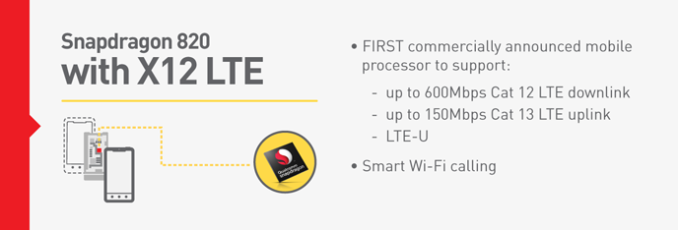Qualcomm Announces Snapdragon 820 Modem Configuration: X12 LTE
by Joshua Ho on September 15, 2015 1:00 AM EST- Posted in
- Mobile
- Qualcomm
- Gobi
- SoCs
- Snapdragon 820

At Qualcomm’s 3G/LTE Summit in Hong Kong, Qualcomm released some details about the modem that will be integrated into their Snapdragon 820 SoC. On the LTE side, Qualcomm is using what they call an X12 modem, which supports UE category 12 on the downlink with speeds of up to 600 Mbps. This is enabled by a move from 64QAM (Quadrature Amplitude Modulation) to 256QAM when compared to previous UE Cat. 9 modems like the Snapdragon 810’s integrated modem. However, given that this is enabled by using higher order modulation schemes there is reduced tolerance for noise within the signal. In some situations, higher speeds might be possible but there’s definitely a point where additional speed isn’t viable through such techniques. On the uplink, category 13 LTE allows for up to 150 Mbps upload by moving from 16 to 64 QAM.
For a single downlink carrier, it’s possible to enable up to 4x4 MIMO which allows for better bandwidth and improved coverage. This should improve bandwidth and/or reception quality when an operator only has a single LTE carrier available. Qualcomm estimates that this should double bandwidth relative to previous LTE solutions. Snapdragon 820 will also carry support for LTE-U when used with Qualcomm’s WTR3950 transceiver, a version of LTE that can run on unlicensed spectrum like 2.4 or 5 GHz for additional spectrum. The new modem will also be able to support antenna sharing schemes between LTE and WiFi, which would reduce the complication of implementing an all-metal unibody design that is popular in smartphones.
For WiFi, it looks like Snapdragon 820 will have a 2x2 MU-MIMO 802.11ac solution, likely to be QCA6174A but it isn’t clear if this is an on-die solution. Given that high-end smartphones tend to ship with Broadcom WiFi/BT modules it’s likely that this is an off-die solution. 802.11ad will also be supported, but once again it isn’t clear whether this is on-die. In the absence of information it’s likely that this is simply the Wilocity WiGig chips like the Wil6200.
The final announcement is one of the first applications of the Zeroth platform/cognitive computing, which is intelligent WiFi and mobile data management. It’s likely that this is an OS-level program that is running on the GPU or DSP which uses a number of factors to determine whether to use WiFi or stay on mobile data. This should improve the user experience by preventing connections to poor WiFi or moving to WiFi when mobile data is running on an overloaded eNodeB and/or experiencing poor signal. This can be turned off as well, which suggests that this is a relatively high-level program.
While we have some information about various bits and pieces of Snapdragon 820, the real points of interest like the exact CPU configuration, Kryo architectural details, and interconnect have yet to be revealed. In the coming weeks, we hope to finally piece together the full picture of what Snapdragon 820 will be.
Source: Qualcomm










14 Comments
View All Comments
extide - Tuesday, September 15, 2015 - link
40 seconds, (Megabit vs MegaByte)Pzenarch - Tuesday, September 15, 2015 - link
... 300MB = 300Mb * 8 = 2,400Mb ...... 2,400Mb / 600Mb = 4 ...
... about 5 seconds is closer. Original poster wins!
Communism - Tuesday, September 15, 2015 - link
Anyone using mobile data other than the original grandfathered 4G LTE Verizon Unlimited plans are simply chumps.None of these increases in theoretical transfer rates are for your benefit. It's so that carriers can cram more data with less spectrum use per bit transferred.
sherifhanna - Wednesday, September 16, 2015 - link
Hey guys - Sherif here from Qualcomm.So this just happened:
http://exchange.telstra.com.au/2015/09/16/telstra-...
The Snapdragon X12 LTE modem, the discrete version of the same one that'll be integrated in the Snapdragon 820, is already delivering those speeds on Telstra's network.